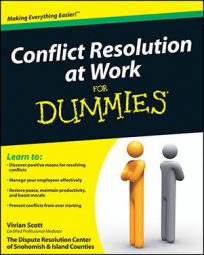Without a doubt, one of the most common topics in workplace-conflict mediation is the breakdown of communication. Such a breakdown may be the root of a conflict itself or a byproduct of it, but, in either case, if you notice deterioration in the way your employees are communicating, step in and help repair it.
On the flip side, after a mediation, you should see improvements in communication. Take into account all the levels of communication: words, tone of voice, and body language, as well as frequency and consistency of conversations.
Paying attention to content: Pay attention to the specific language employees use after a conflict meeting. Small changes like using “we” and “us” instead of “you” or “they” can be easy to miss, but the subtle change provides a powerful example of a shift in perspective from isolated and separated individuals to a cohesive team. Amending word choices can also indicate an increase in respect, awareness of others, and humility.
How an employee speaks about a prior conflict may determine whether future problems are imminent. Is he wallowing in everything that went wrong, or is he optimistic that things are now on the right path? There’s a huge difference between “I’ll believe it when I see it” and “I’m hopeful we’re moving in the right direction.”
Distinguishing tone of voice: How a message is delivered is just as important as the words an employee chooses. Shifts in tone of voice can speak volumes about how well people are getting along. A moderate tone, rather than loud or demanding voices or snide comments mumbled under a co-worker’s breath indicate a reduction in the conflict’s intensity.
Pay attention to whether employees are comfortable speaking freely and sharing ideas with each other, as opposed to avoiding or withdrawing from communication because of harsh or condescending tones.
Observing body language: You may have an employee who tends to express himself more in actions and movements than he does with words. Whether it’s eye rolling, crossing his arms, or stomping down the hall, these actions speak loud and clear about how he’s feeling. He may be doing it on purpose, to prove a point, or he could be completely oblivious to his actions. If you observe postures that are aggressive and intimidating to other co-workers, coach the employee on body language.
Watching reactions to difficult conversations: Gauge how respectful the communication really is. On the surface, everything may seem fine, but if you dig a little deeper, you may notice that problems still exist. Pay special attention to the way employees handle themselves in difficult conversations.
Peer feedback is a particularly sensitive manner of communication, so if you notice your employees are doing it well, that’s a great sign that communication has improved. If it’s going poorly, that may be your cue to do one-on-one coaching or call another session to uncover what’s still unresolved for one or both of the parties.
Monitoring gossip levels: Gossip is a clear sign of continued conflict. Listen for it and note whether it’s decreased in frequency, stayed the same, or gotten worse since the mediation.
Gossip and rumors are a serious red flag that the root of the conflict hasn’t been successfully addressed. One or more of the employees who participated in the conflict meeting having hushed conversations with co-workers may be a sign of residual frustrations.

